Text
Contemporary art reflective blog
My name is Helen, I am a mature first year undergraduate History of Art and Museum Studies student. For the contemporary art module, we have been asked to create a blog on how we understand and connect to contemporary art. This is where I have to confess that out of all the modules that we have studied this is the one that I feel I connected to the least.
I am hoping by the end of this blog and through my own research to have deepened my understanding and gained a better insight into contemporary art.
I have grown up in and around Renaissance art having spent a quite a bit of time in Florence with the family I have there, the time spent in art galleries like The Uffizi, The Accademia and the Pitti Palace deepened my love of all things ‘old’ so the modern contemporary art I just do not feel like I understand quite so well.
Medusa with the Head of Perseus
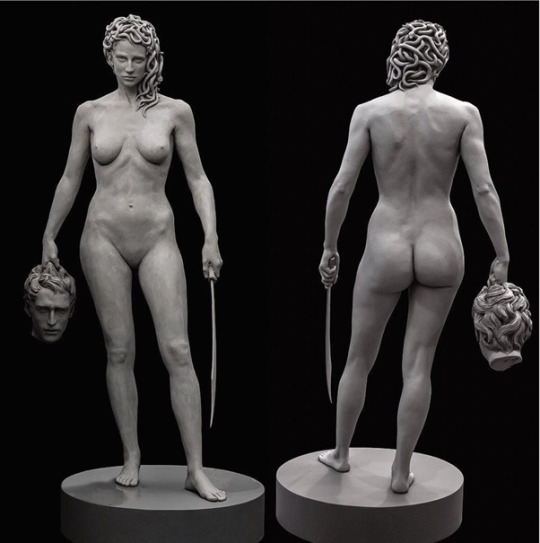
'Medusa with the Head of Perseus', by artist Luciano Garbati. COURTESY OF MWTH PROJECT AND THE ARTIST
Luciano Garbati is an Argentine-Italian artist who grew up in a little village just outside Florence. In the Piazza della Signoria sits the famous Cellini sculpture for all to see. In this sculpture Perseus stands naked atop of Medusa’s corpse, holding her head aloft in victory over the crowds that gather in the square, every child in Florence knows the story.

As Garbati told Quartz’s Annaliese Griffin in 2018, seeing the work as a child led him to imagine a reversal of its dynamic.
“There are lots of depictions of Medusa, and they are always describing the myth at its worst,” the artist said. “… What would it look like, her victory, not his? How should that sculpture look?”
Medusa was a handmaiden of Athena’s sacred temple and one day Poseidon tried to seduce her, she rebuffed his advances as it would jeopardise her position in the temple, not taking no for an answer Poseidon raped Medusa. When Athena found out she, in a fit of rage for defiling her temple, turned Medusa into a Gorgon with deadly snakes for hair and a gaze that would turn anyone she looked at into stone, she banished Medusa from the temple.
A number of years later Perseus was sent on a seemingly imposible task to kill Medusa and cut off her head as a gift. Not being able to look directly at Medusa Perseus used the reflection in his shield to complete the job and take her head.
In Garbati’s sculpture things are a little different, Medusa’s lithe body is naked, she still has the snakes for hair and she is still a beautiful maiden, but in one hand she clutches a sword and in the other the severed head of Perseus (modelled on the artist) but its her gaze that catches the attention of the viewer, head tilted slightly downward, there isn’t a glee to her victory just a quiet resolution that she got the job done and woe betide anyone else who tries to take her life from her, inviting the narrative that she as a rape survivor, she will rise and that victim shaming is both wrong and immoral. This has been highly publicised recently in the media with the #metoo movement.
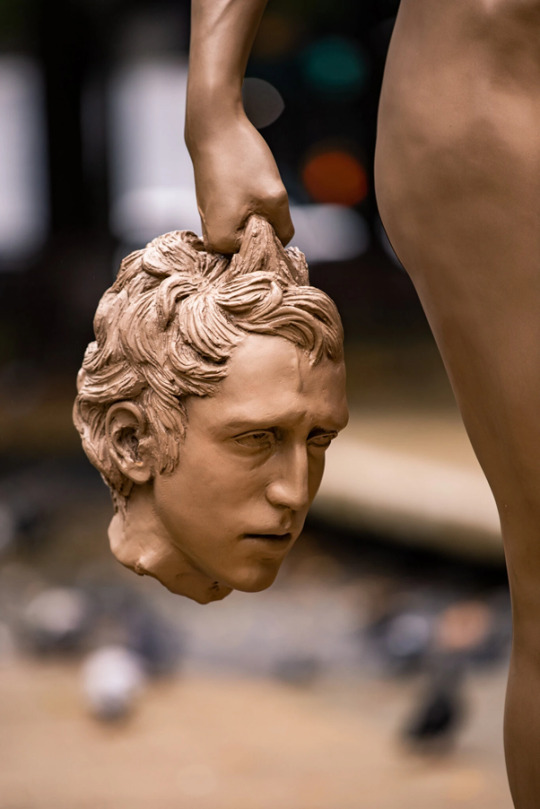
Photograph Jeenah Moon for the New York Times
Although Garbati created Medusa with the Head of Perseus in 2008 the sculpture was chosen to be erected in 2019 directly opposite the New York County Criminal Court, where Harvey Weinstein stood trial prompting a mixed reaction from the #metoo movement. Medusa has been reinterpreted as being symbolic of the victim-blaming suffered by rape survivors. “How can a triumph be possible if you are defeating a victim,” Garbati said in a statement.
On his Instagram page, Garbati wrote, “The place chosen is not accidental, since there they judge cases for crimes related to violence against women. We are already in the final stage working on the last details of this sculpture that became a symbol of justice for many women.”
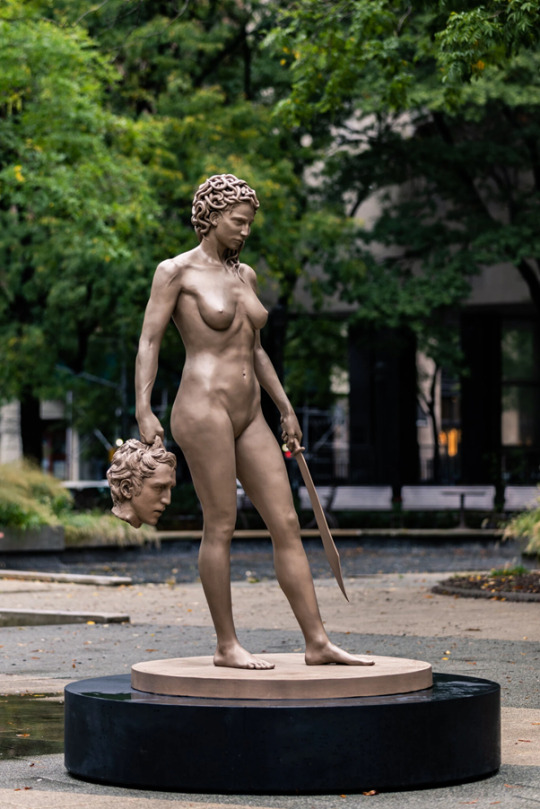
Photograph Jeenah Moon for the New York Times
Some women were outraged that a male artist was chosen to represent their voice saying that Medusa’s body was too perfect and Poseidon’s or Athena’s head ought to be at Medusa’s side, not Perseus’s as they were the initial perpetrators.
Regarding Medusa’s model-esque figure, Mr. Garbati suggests that critics consider the literature from a recent exhibition at the Metropolitan Museum of Art that chronicles how artistic depictions of Medusa morphed from beastly to beautiful starting in the fifth century B.C. You can find that information here https://issuu.com/metmuseum/docs/dangerous_beauty_winter_2018_bullet
The feminist activist Wagatwe Wanjuki, who has written extensively on violence against women, wrote on Twitter, “#Metoo was started by a Black woman, but a sculpture of a European character by a dude is the commentary that gets centered? Sigh.”
But what if we have the story wrong, what if it’s been interpreted incorrectly all this time? What if Athena was in a fit of rage because her maiden had been raped? What if she was so angry that she turned the beautiful Medusa into a Gorgon to protect her from being a powerless victim? What if she sent her away to safe place where no one would find her? What if, what if, what if….
You can find Luciano Garbati’s web page here https://www.lucianogarbati.com/
Faith Ringgold
I first came across Faith Ringgolds work in a lecture we had about the Harlem Renaissance and the impact of the Windrush generation on art at that time, how black artists were using art, music, dance and other mediums to comment on the political status of the era and the black community’s social standing.
What first caught my eye was the riot of beautiful colour Ringgold uses, also that she uses the traditionally ‘gentle’ medium of quilting to depict such abject horrors such as racism, segregation, riots and street violence.
This led me to find out more about her life as an artist and civil rights activist, she is a mesmerising character and I watched many interviews with her, this one was particularly interesting as she was accompanied by her black feminist author and cultural critic daughter Michelle Faith Wallace. Watch it here https://www.youtube.com/watch?v=GK6G-S33V6w
Faith Ringgold was born in Harlem New York in 1930 at the tail end of the Harlem Renaissance.
Harlem welcomed thousands of African Americans from the southern states of America, they moved to escape the prejudice and persecution that was going on at this time. Many famous people settled in Harlem such as Duke Ellington and Ella Fitzgerald also authors, artists, musicians and athletes flocked to this area. It was an exciting time in Harlem and the Harlem Renaissance was born.
Faith Ringgold attended City Collage New York where she studied art from the European Masters such as Da Vici, Van Goch and Titian. Although she learned from them, she thought “I am black, I am a woman and I am of African descent” so she started to look at African art that was brought to Harlem by her relatives, she started to make quilts with her own twist on the designs, this led her to making her quilt stories, a series of quilts depicting the plight of African Americans in Harlem at this time, dedicating her career to activism, fighting gender and racial equality and highlighting the horrors of the race riots.
Echoes of Harlem 1980 is the first quilt of the series. This was a collaboration with her mother (who she called Willy) and was made the year before Willy died, this was the only one they collaborated on together. It features all the faces of her neighbours and friends in Harlem and takes the traditional tanka for inspiration. The fabric was quilted on to wadding and then the images were painted directly on to the fabric. This meant she could roll them up and easily transport them to various galleries as she found her paintings too heavy to lift and did not want to wait for her husband to arrive home from work to help her lift her canvases.
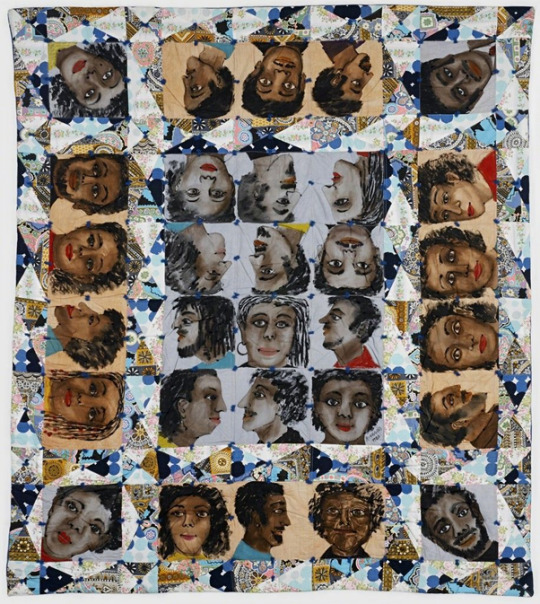
Echoes of Harlem 1980 photo Artsynet
Street Story 1985 This a quilt that features her house in Harlem, 222 West 146th Street. It also shows the burned-out houses of her neighbours after the civil rights rioting took place.
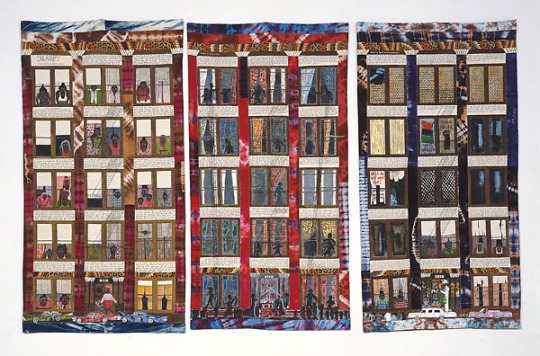
Street Story 1985, photo metmuseum.org
Sonny’s Quilt 1986 This quilt depicts her legendary neighbour saxophonist Sonny Rollins who would practice playing his tenor saxophone on the Brooklyn bridge to get away from complaining residents.

Sonny’s Quilt 1986, photo Artsynet
Tar Beach 1988 This quilt depicts the hot summers of Faith Ringgold’s childhood, no one had air conditioning and the families of Harlem could not afford holidays so instead they would use the roofs of the apartment blocks to get away from the stifling heat of the city. This was as a place to spend recreational time. They called it Tar Beach. Families would gather with friends and neighbour’s, children would fall asleep under the stars as the adults played card games, listened to music and told stories passed down for generations. This quilt captures the magic she felt on the roof top, the George Washington bridge in the background, the stars above their heads.
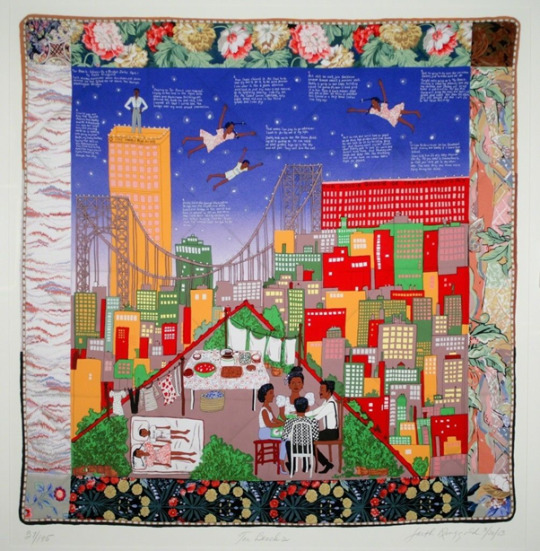
Tar beach1988, photo Artsynet
When Faith was a child, she was sick much of the time with asthma so consequently spent a great deal of her time absent from school, the roof top was where her fashion designer mother Willy taught her to sew. On the days that she was well enough her mother would take her to the theatre to watch Jazz performances, these are portrayed in later story quilts.
Harlem reflects heavily in Ringgold’s work, from the connection and love she felt with friends and family to the outpouring of rage, despair and inequality felt by the Black community at the time. She used her work to depict the political tensions on the streets of New York.
To find out more about Faith Ringgold’s extraordinary life and works of art including paintings, books, and many more quilts please start by taking a look here www.faithringgold.com
Tracey Emin, Everyone I Have Ever Slept With 1963–1995
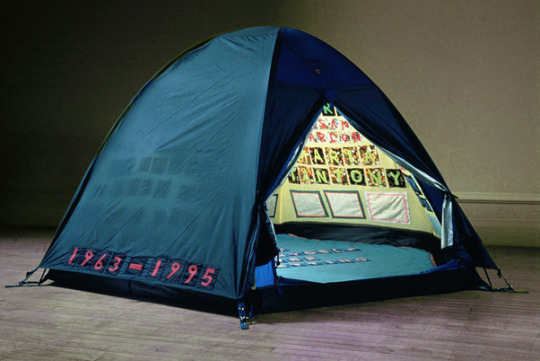
Photograph Wordpress
Tracey Emin is a British artist most associated with the art movement of the late 1980’s early 1990’s in London called the Young British Artists or YBA’s, with most of the artists graduating from Goldsmiths or the Royal Collage of Art.
Emin hand stitched and appliqued over 100 names of everyone she had ever slept with up until this point on a tent. The tent filled her small living room floor for six months whilst she worked on it, having to put her television inside it to fit it in the room.
I find this piece fascinating for a number of reasons, firstly the way the media reacted to it. The Tent as it is sometimes known, got such bad press as I think it was just too much information about Emin’s sexuality and private life for most of the general public, jumping to the hasty conclusion that all the names in and on the tent were sexual partners when in fact the literal meaning of the word ‘slept’ in the title was including all the people she had ever fallen asleep in the same place as, names included her Grandmother who she used to fall asleep besides listening to the radio, her teddy bear, two unnamed aborted foetuses and school friends. Of course, Emin had the names of past and present lovers and one-night stands in there also, but the deliberately provocative title of the piece meant that people jumped to their own conclusions without considering that there may be names of people in there with innocent connotations.

Photograph Wordpress
The second reason I like this installation is because it reminds me of Duchamp’s ‘Readymades’. Emin has taken a mass-produced boring plain two-man tent and added something to make it extraordinary, and thought provoking. So, I find myself thinking would it be as striking and controversial if it wasn’t for Tracey Emins brash, eccentric, feisty and at times unpredictable personality? After all it is just a tent with some names sewn on.
The Tent was first shown at Minky Manky at the South London Gallery and the brainchild of Carl Freedman (who Emin was in a relationship with at the time) He was a friend and collaborator of Damien Hirst who also exhibited in the gallery along with YBA’s such as Sarah Lucas and Gilbert and George. This gave Emins work a much-needed boost as she was not as well-known at this point.
Emin tells Widewalls ‘At that time Sarah (Lucas) was quite famous, but I wasn't at all. Carl said to me that I should make some big work as he thought the small-scale stuff I was doing at the time wouldn't stand up well. I was furious. Making that work was my way at getting back at him. One review was really funny, the journalist had written something like 'She's slept with everyone – even the curator'!
Charles Saatchi the well-known art collector, Gallery owner and wealthy patron of Hirst and many of the YBA’s wanted to buy The Tent but Emin wouldn’t sell it to him due to his advertising work for Thatcher administration. Saatchi eventually bought it on the secondary market from another dealer and put it into his storage facility at the East London Momart warehouse where it was destroyed by fire along with many other valuable pieces of art.
In 2008 during her Edinburgh retrospective show, Emin claimed that she was offered £1 million by the Saatchi Gallery to rebuilt The Tent, but that she cannot do it since it was very personally despite the fact she recreated few smaller pieces for that show. (Widewalls 2020)
To find more about Tracey Emin’s tent watch this short clip https://www.widewalls.ch/magazine/tracey-emin-everyone-i-have-ever-slept-with
Eve Provost Chartrand
In mid-February we had a guest lecture by the Canadian artist Eve Chartrand, I found her work quite disturbing to look at at first, her organic matter looking creations that incorporate teeth, wax, fabric and living fungi can look like something out of a horror film. But then listening to what motivated her to produce her works really resonated with me.
Chartrand has been observing in her art how ‘she experienced first-hand how disabled and “disgraceful” bodies trigger unease, contempt, and/or indifference, even violence. Living in a culture that equates old age with disease and decline (Calasanti 2005) compelled me to find ways to resist and transgress such discriminative gazes’.
As a woman of 44 I can tell you that I am treated differently now to how I was treated in my 20’s. It is like you become invisible or perhaps treated as a slight inconvenience, like your opinion does not count as you are not young. How the adverts on television are reminding you that you must not age, to stay thin and retain the appearance of a perpetual twenty something with long thick lustrous pigmented hair, wrinkle free and with the perfect figure. And the cruel reality is as you start to feel the most comfortable with yourself that’s when your body starts to age and diminish the youthful lustre it once held. When did it become the norm for the media to tell us that the aging process is not acceptable, beautiful or inevitable? Is the media the new male gaze?
Chartrand’s work challenges the viewer to see beauty in ageing, unconventional bodies, frailty and diversity.
Chartrand’s work entitled ‘Is there anybody home?’ was inspired by losing elderly relatives, witnessing the aging process and using childhood memories to create sculptures that conveyed the smells, tastes, vibrations of previous experiences. This body of work particularly stuck a chord with me as I have elderly parents and recently lost a most beloved Aunt, Chartrands work made me think about what I hold dear and after my loved ones have gone what would I have to remember them by.
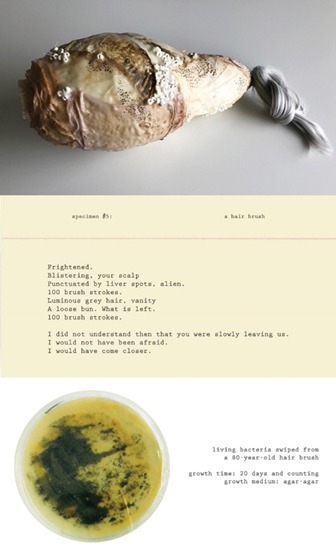
Is There Any Body Home? Specimen #5: A Hair Brush. 2018 Eve Provost Chartrand
Chartrand explained in her lecture that she made this after rummaging through a box of mementos and keepsakes of her Grandmother who she was afraid of when she was a child. The poetry is typed on velum to mimic the fragility of aging skin mirroring it with a slightly translucent quality.
The bacteria grown in the petri dish was taken from a swab of Chartrand’s Grandmothers 80 year old hair brush. The idea that you can resurrect a living organism (all be it bacteria) from a relative or loved one’s belongings I find fascinating and macabre at the same time. The thought is comforting to me that even when someone is long gone a part of that person still remain and can bloom into life once more.
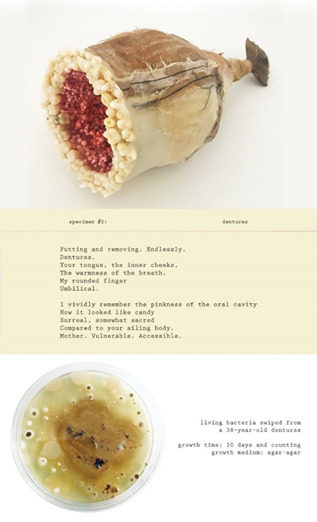
Is There Any Body Home? Specimen #2: Dentures. 2018 Eve Provost Chartrand
Find more of Chartrands work here https://www.eveprovostchartrand.com/
Andy Goldsworthy
Andy Goldsworthy is a site-specific artist who works outdoors with natural found materials such as leaves, twigs, rocks, ice and water. He uses these materials to compliment the landscape and documents the breakdown or decay of the installations by photographing them at different stages. His work is none permanent and open to elements which give them a fleeting beauty.
“It's not about art,” It's just about life and the need to understand that a lot of things in life do not last.” He told the Guardian

Photograph by Artsynet
Instead of using canvas, paints, clay, tools and other traditional artist materials Goldsworthy instead opts for what nature provides him. Choosing not to paint landscapes but rather paint on them, in them or around them, incorporating the seasons, the weather and the tides. Nothing he creates is permanent and every component as natural, even down to the thorns he uses to fix leaves in place.

Photograph Artsynet
I think Goldsworthy’s art is particularly poignant at this current time. The global pandemic rendering travel out of the question so people have been able to explore the countryside around them, many of them for the first time. Busy lives, jobs, and schooling have us all on the giant treadmill of life, it has taken a catastrophic advent for all to slow down and enjoy walking in the countryside, local parks, gardens and shorelines of Britain, watching seasons come and go, watching nature in her great cycle realising that to take care of our earth provides a wonder for us all and our future generations.
Goldsworthy states in his book Passage ‘An artist makes things that become a focus for feelings and emotions - some personal, some public, some intended, some not. At best a work of art releases energy that is a shock to both the artist and the viewer – I do not mean shock in the conventional sense but an emotional tremor that articulates a feeling that has been in search of form’ (page 69)
The transience of Goldsworthy’s art can also be likened to the way that contemporary art is fleeting, what is considered to be contemporary at this present moment in time will undoubtedly be not what we would consider it to be in 10, 20 or 50-years’ time. Art that is created today is considered contemporary but all art was created ‘today’ that day and then we will have to find another name to call it, another category to fit it in to.
I have learned in the duration of completing this blog that I very much enjoy some contemporary art, I may need to do some research into the piece that I am looking at to understand the artists meaning behind their work, or that I may have to understand the actual artist and their background before I can fully appreciate what they are communicating, I know now that I will be slowing down in the contemporary art room in the Walker Art Gallery the next time I visit instead of rushing through, I will take time to read the information the galleries provide and continue to learn, who knows, maybe I will find a new passion I did not think possible.
4 notes
·
View notes